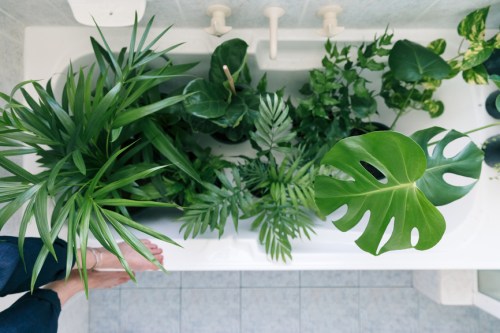Our editors independently select these products. Making a purchase through our links may earn Well+Good a commission
This ‘Bottom-Up’ Hack Makes It Impossible To Overwater Your Plants
Bottom-up wattering allows your plants to get water right at the roots, and they'll only drink as much as they need, making overwatering next to impossible.

In my house, plants often flirt with death before I realize that something is wrong. Am I overwatering my plants? Underwatering? It’s hard to tell. Bottom-up watering takes the guesswork out of the equation.
Experts in This Article
former director of brand marketing at The Sill
“With bottom-up watering, you’re giving your plant water where it needs it the most—right at its roots! Through the holes in the bottom of its grow pot or planter, water saturates the potting mix like a sponge, and roots are able to reach that water and pull it up through the plant,” says Erin Marino, director of brand marketing at The Sill. “This is a great way to avoid overwatering your plants and why some plant parents keep their new plants in nursery grow pot until they’ve outgrown them. Roots will take what they need and you can dump out the leftover excess water.”
The bottom-up watering method works for just about any type of plant. “If your plant has a short root system, like most succulents which have adapted to arid conditions, it might take a bit longer for the roots to pull up the water and you could find that watering top-down, directly in the potting mix, works better,” says Marino. “But there’s no right or wrong way! Do what works best for you.”
If you’re unsure when your plants are ready for a bath, a water meter like the Dr. Meter S10 Soil Moisture Sensor Meter ($11) is useful. “Water meters can be incredibly helpful,” says Marino. “They are easy to read and save you from sticking your fingers deep into the potting mix to check for moisture. I find that they are incredibly helpful for larger plants, where digging a finger into the soil isn’t as feasible. I definitely recommend it for anyone who tends to overwater their plants! You’d be surprised how long your regular potting mix can hold moisture for.”
Additionally, you can look out for the signs of under or over watered plants. “Underwatered plants tend to wilt or wrinkle. Sometimes leaves will look dry and crispy, which can also be a sign of low humidity,” says Marino. “Overwatered plants tend to get mushy, and soil will stay moist and not dry out. Leaves can also start to yellow and brown.”
Bottom line? Listen to your plants, follow the plant equivalent of intuitive eating, and you won’t have to guess if your plant is thirsty (or drowning).
“It’s okay to be flexible in your plant care habits,” says Marino. “Skip the specific schedule and instead check in with your plants regularly and monitor how water affects your plant. For most plants, only water when the potting mix is dry! It’s always easier to add water than it is to remove it.”
Oh hi! You look like someone who loves free workouts, discounts for cult-fave wellness brands, and exclusive Well+Good content. Sign up for Well+, our online community of wellness insiders, and unlock your rewards instantly.









